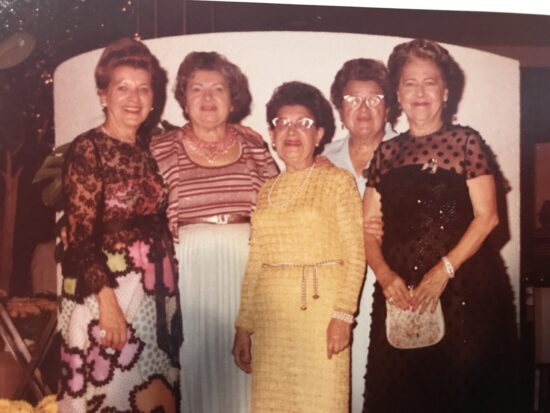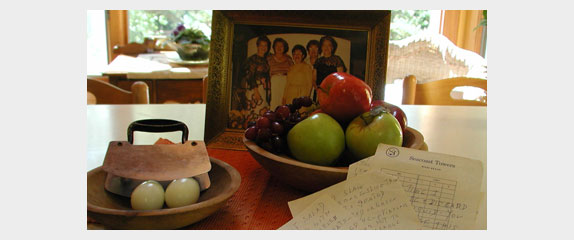The Wooden Bowls
I wrote this piece just after my nana, Beatrice Bloom, passed away on Valentine’s Day 2000. On this 11th anniversary of her death and the upcoming Passover holiday I wanted to share this personal reminiscence with you.

From left to right:
Beatrice, Lily, Frances, Ruth and Rose
I was on my hands and knees, plucking pot after broken-handled pot from beneath my Nana’s cabinets cluttered with kitchenware accumulated after the death of each of her four sisters. “Who needs to spend money on new pots with all these?” I imagined her saying.
Imagined indeed. My grandmother, Beatrice Bloom, had died just days before, at age 94, and I was helping my mother clean out her apartment in Miami Beach. The mound of pots grew while thoughts and images of the formidable, widowed Cohen sisters: Aunts Rose, Ruth, Francis and Lilly, came alive. Rose, the undisputed matriarch and best cook, Ruth the best baker, intrepid Lilly (who at 84 showed up, alone at our Tokyo apartment), and Francis and Beatrice– working girls until well into their late 70’s.
And then, like a miner hitting a vein of gold, I found what I knew had to be there somewhere– two shallow, elliptical wooden bowls nestled together. Pulling them from the darkness of the cabinet, in tears, I brought them close to my nose and breathed deeply, smelling more than half a century of Friday night and holiday dinners. Nothing triggers memories like aromas. There I was, in February 2001 on the floor of a kitchen in Miami, transported decades back to the New York City apartment my grandmother and her sisters Rose and Francis shared.
Frazzled from a Friday night ride on the Long Island Expressway, we step off the elevator into the hallway of Beatrice’s apartment building, and are met by the distinctive smells of Eastern European Jewish cooking. We could have picked any floor in that building or any other in the neighborhood where Jewish women were preparing dinner, and would have felt right at home.
Chopchopchopchopchop– the rhythmic sound of metal blade hitting wooden bowl at rat-a-tat speed. The smell, oh the smell. Onions being fried in chicken schmaltz (chicken fat) permeated the hallways and infused my soul. What treats lay behind the door of Apartment 7B! Roast Chicken, Chicken Soup with Matzoh Balls, sweet noodle pudding…
Upon entering the apartment, there would be a flurry of hugs and commands. My two brothers, and father were set upon. If a male attempted to follow his nose across the culinary 38th Parallel of Aunt Rosie’s kitchen, they were chided and shooed “Out, out, out!” I alone was allowed into the kitchen where a flushed Aunt Rose held the double-bladed chopper above the wooden bowl and exclaimed “Debala (little Debbie in Yiddish) how about a little taste?” She filled a spoonful of chopped liver scraped from the bowl and into my mouth. (Even at age 10, I loved this stuff!) Before I could answer, Rosie would say “more salt,” and toss crystals of kosher salt into the bowl, in perfect unmeasured proportion.
But the single magic ingredient (or lethal weapon, as we now know) was chicken schmaltz. A jelly-glass full of the weeks of rendered chicken fat– resembling strata of sedimentary rock– sat inside the refrigerator door. A dollop was always added to the chopped chicken livers, fried onions and hardboiled egg mixture. It was guaranteed to take you to Jewish Nirvana and probably was responsible for more than a few triple by-pass operations.
A basket of fresh challah is on the center of the table set with a beautiful linen cloth, the good china and silver. Finally we are all seated. My Nana and Aunt Francis serve the first course. Happy and chatting, we spread the chopped liver onto the challah.
Aunt Francis reaches for the salt– big mistake. “What are you doing?” demands Rose. “It needs salt,” Francis explains. “No it doesn’t” retorts Rosie as she reaches into Aunt Francis’s plate with her fork, confirming her pronouncement. Then an exchange of “no it doesn’t, mind your own business, what do you know” ensues. The girls, even as octogenarians, never agreed on much. I always wondered why the salt and pepper shakers were out on the table, as they were purely for decoration.
Herring, gefilte fish, and walnuts were chopped for a variety of dishes in those wooden bowls. My great-grandmother, who came to this country from Poland, observed kosher rules. She used different bowls for different foods. As time passed, however, the next generation dropped this custom, replacing it with a good washing instead.
My mother, Rona Greenberg, has her own wooden bowl, and when I got married, part of my ‘dowry’ was a new wooden bowl and chopper. Customs changed over time as we assimilated into American culture. My great-grandmother’s Shabbos (Sabbath) dinner with candles and prayers, turned into a regular Friday night gathering of cousins in my mother’s generation, before it became dinner at Nana’s when I was a kid. And now what is it? Pizza and a video after a long week of work and busy schedules.
Yes, I do use my wooden bowl, sometimes even for making chopped liver. To be honest, though, I more often hit the pulse button on the Cuisinart. But, against my better judgment, I do skim the fat off the top of the chicken soup and add it to the batter for making matzoh balls– you get a much lighter ball and not a bomb that sinks to the bottom of the pot. However, I also crush sesame and fennel seeds and mash tofu in this same wooden bowl. Sorry girls.
With my Nana’s tchotchkes (“stuff” comes closest in English) and those two bowls as carry-ons, I returned to Boston from Miami. I was richer than when I left. Fighting my sentimental instincts, knowledge about bacteria forced me to put the bowls into the dishwasher. Today they are on my kitchen counter, filled with fruit and memories.
Gut Yuntuf (Yiddish for Happy Holidays) Nana and Aunties. For this year’s Rosh Hashanah dinner I will use your bowls to make chopped liver, and add an extra spoonful of shmaltz with a dash of tears. No one had better reach for the salt.
Aunt Rosie’s Chopped Liver (serves 8 as an appetizer)
There are as many methods for making chopped liver, as there are Jewish mothers.
My paternal grandmother, Bess, used mayonnaise as her secret ingredient, to no end of disdain from the Cohen girls.
1 pound fresh chicken livers
2 large onions
2 hardboiled eggs
2-3 tablespoons vegetable oil or chicken shmaltz(fat)
Kosher salt and pepper to taste
1. Clean and separate chicken livers. Place chicken livers in a baking dish and broil for 2 minutes. (My mother in law boils them for about 3 minutes).
2. Chop onions and sauté in a frying pan with the oil(chicken shmaltz) for 15 minutes until they are very soft and brown. If you dare, fry them in rendered chicken fat.
3. Add the chicken livers and sauté an additional 3 minutes. Remove from heat and let cool.
To mix by hand in a chopping bowl:
1. Finely chop hard-boiled eggs and set aside.
2. Vigorously chop the onion and liver mixture until well blended and spreadable. Add the eggs and mix with a spoon. Season with salt and pepper to taste.
To mix by food processor:
1. Put eggs in processor bowl and with ‘s’blade hit the pulse button 3-4 times. Remove to a separate bowl.
2. Add the chicken livers and onions to processor bowl and hit the pulse button about 7-8 times. Add to the egg mixture and mix well.
Season with salt and pepper.
If the mixture is a little dry, you can add a little oil, chicken shmaltz or mayonnaise.
To serve individually:
On a small plate, place a mound of about 3 tablespoons on a lettuce leaf garnished with tomato wedges. Serve with Challah, matzoh, or crackers like Tam Tams(Manishewitz Brand)
Grandma Rita’s Mock Chopped Liver (Vegetarian)
This is my mother-in-law Rita Schwartz’s delicious and lower fat alternative to the real thing. “You know we all have to watch it these days, says Grandma Rita.”
1 8 ounce can green beans
1 8 ounce can green peas
15 Tam Tam crackers
2 large onions, chopped
3 hard boiled eggs
1 tablespoon low fat mayonnaise
1 cup chopped walnuts
salt and pepper to taste
1 tablespoon vegetable oil
1. In a frying pan, sauté onions for 15 minutes until soft and browned.
2. Put the onions alone in the food processor and pulse 3-4 times and remove.
3. Place walnuts and Tam Tam crackers in the food processor bowl and pulse until just broken up.
Add the vegetables, hard boiled eggs and process until smooth.
4. Finally add the onions to this mixture and pulse another 3 times.
5. Scrape into a mixing bowl. Add mayonnaise, salt and pepper to taste.
Chill for at least 2 hours.
Rosie’s Herring Salad (serves 12)
This is like a pate and is delicious with crackers
2 jars pickled herring filets (not in cream sauce) with onions
2 apples peeled and grated
¾ cup walnuts
2 hard boiled eggs
1-2 teaspoons lemon juice
1 teaspoon sugar
¼ cup sour cream(you can omit this)
1. Drain herring filets and reserve the liquid.
2. Chop herring and onions finely in a bowl or pulse about 6 times in a food processor.
3. Place in a bowl and add the grated apple, ½ cup of chopped walnuts, hardboiled egg, lemon juice, sugar and a few teaspoons of the pickling liquid.
4. Season with salt and pepper.
5. Serve with crackers on a platter. Garnish with the remaining walnuts.
Rosie’s Waldorf Salad (serves 4 as a first course)
Old fashioned and simple to make, this salad is quite refreshing. It also makes a great dessert.
2 Red Delicious Apples
2 Golden Delicous or Granny Smith Apples
2 tablespoons each, mayonnaise and sour cream
3 stalks celery, diced
1 cup green grapes halved
1/2 cup walnuts, chopped
lemon juice and sugar to taste
1. Wash, cut and core apples. Do not peel. Cut into bite-size pieces. Place in a bowl and sprinkle with lemon juice.
2. Add diced celery, grape halves and walnuts
3. Mix sour cream and mayo together. Fold into salad. Chill for 2 hours.
4. Serve in individual glass compote cup. Sprinkle on chopped walnuts as a garnish.
How to Render Chicken Fat
(Adapted From the New Jewish Cookbook – Hebrew Publishing 1947)
Cut skin from any kind of fowl and remove fat.
Heat fat in a frying pan until it melts. Reserve in a jar.
For a special treat (I’m not kidding) the skin of the chicken and chopped onions would be fried in the chicken fat until crispy. Then drained on paper towels.
This is called Grieben. My mother says she and her brother would wait like little birds at the stove while my Nana made this. It rivals the skin on a roasted turkey.












 Debra Samuels, bestselling author, food writer and cooking instructor,
Debra Samuels, bestselling author, food writer and cooking instructor,